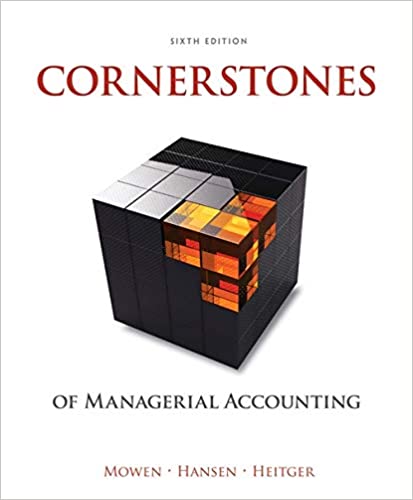
Cornerstones of Managerial Accounting 6th Edition by Maryanne Mowen,Don Hansen ,Dan Heitger
Edition 6ISBN: 978-1305103962
Cornerstones of Managerial Accounting 6th Edition by Maryanne Mowen,Don Hansen ,Dan Heitger
Edition 6ISBN: 978-1305103962 Exercise 48
Analysis of Accounts Receivable and Credit Policy
Based on customer feedback, Ted Pendleton, manager of Gray Company, which produces photo supplies, decided to grant more liberal credit terms. Ted chose to allow customers to have 60 days before full payment of the account was required. From 2012 through 2014, Gray's credit policy for sales on account was 2/10, n/30. In 2015, the policy of 2/10, n/60 became effective. By the end of 2016, Gray was beginning to experience cash flow problems. Although sales were strong, collections were sluggish, and the company was having a difficult time meeting its short-term obligations. Ted noted that the cash flow problems materialized after the credit policy was changed and wondered if there was a connection. To help assess the situation, he gathered the following data pertaining to the collection of accounts receivable (balances are end-of-year balances; the 2012 balance was the same as that in 2011):

Required:
Note : Round answers to two decimal places.
1. Compute the number of times that receivables turned over per year for each of the 5 years. Also express the turnover in days instead of times per year.
2. CONCEPTUAL CONNECTION Based on your computation in Requirement 1, evaluate the effect of the new credit policy. Include in this assessment the impact on the company's cash inflows.
3. CONCEPTUAL CONNECTION Assume that the industry has an average receivables turnover of six times per year. If this knowledge had been available in 2014, along with knowledge of the company's receivable turnover rate, do you think that Ted Pendleton would have liberalized his company's credit policy?
Based on customer feedback, Ted Pendleton, manager of Gray Company, which produces photo supplies, decided to grant more liberal credit terms. Ted chose to allow customers to have 60 days before full payment of the account was required. From 2012 through 2014, Gray's credit policy for sales on account was 2/10, n/30. In 2015, the policy of 2/10, n/60 became effective. By the end of 2016, Gray was beginning to experience cash flow problems. Although sales were strong, collections were sluggish, and the company was having a difficult time meeting its short-term obligations. Ted noted that the cash flow problems materialized after the credit policy was changed and wondered if there was a connection. To help assess the situation, he gathered the following data pertaining to the collection of accounts receivable (balances are end-of-year balances; the 2012 balance was the same as that in 2011):

Required:
Note : Round answers to two decimal places.
1. Compute the number of times that receivables turned over per year for each of the 5 years. Also express the turnover in days instead of times per year.
2. CONCEPTUAL CONNECTION Based on your computation in Requirement 1, evaluate the effect of the new credit policy. Include in this assessment the impact on the company's cash inflows.
3. CONCEPTUAL CONNECTION Assume that the industry has an average receivables turnover of six times per year. If this knowledge had been available in 2014, along with knowledge of the company's receivable turnover rate, do you think that Ted Pendleton would have liberalized his company's credit policy?
Explanation
Accounts receivable turnover:
• Account...
Cornerstones of Managerial Accounting 6th Edition by Maryanne Mowen,Don Hansen ,Dan Heitger
Why don’t you like this exercise?
Other Minimum 8 character and maximum 255 character
Character 255


